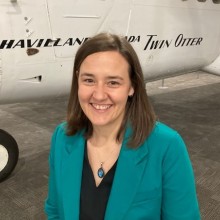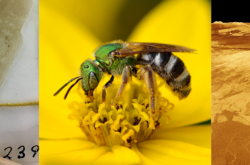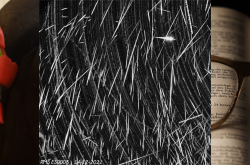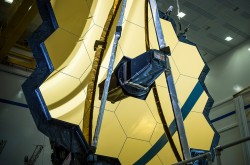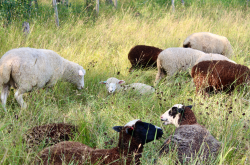3 things you should know about lavender, the Ingenuity helicopter, and cicadas

Meet Renée-Claude Goulet, Cassandra Marion, and Olivia Béchard.
They are Ingenium’s science advisors, providing expert scientific advice on key subjects relating to the Canada Agriculture and Food Museum, the Canada Aviation and Space Museum, and the Canada Science and Technology Museum.
In this colourful monthly blog series, Ingenium’s science advisors offer up quirky nuggets related to their areas of expertise. For the June edition, Renée-Claude Goulet stepped aside and invited student intern Kyra Simone to add her voice to the column. Collectively, the writers tackled Ontario-grown lavender, NASA’s Ingenuity helicopter on Mars, and the invasion of Brood X cicadas. Read on!

Lavender’s distinct purple blossoms and aromatic essential oil are used in personal care products, high-end cuisine, and bug repellent.
Southern Ontario lavender farms are a Mediterranean delight
Grab a glass of wine and imagine looking out over the bright blue ocean — let's talk about a taste of the Mediterranean, found right here in Canada!
While we don't have the Côte-d’Azur, Canada is home to the Purple Road: a collection of lavender farms and shops in southern Ontario. Most of the country's lavender is grown in this area, which shares a similar latitude with Provence, France.
These well-loved purple flowers (genus Lavandula) are actually part of the mint family. The name comes from the Latin "lavare," which means "to wash." Lavender has been used for centuries for its fragrance and medicinal properties, and remains a key ingredient for reducing stress, repelling bugs, preventing infection, and even seasoning food. The vibrant fields of blossoms also make popular photography and agritourism destinations.
Because lavender is native to the Mediterranean, it requires a similar growing environment. Luckily, certain geographical conditions produce microclimates that allow the plant to thrive. For example, large bodies of water regulate extreme temperatures, so it makes sense that many Ontario farms are clustered around the eastern Great Lakes.
Lavender hates having wet feet. It needs well-draining soil without much clay, so that its roots get enough oxygen and avoid rot. Ontario's high humidity can also lead to mold problems, so plants are spaced out to let wind "blow-dry" them naturally! Ideally, fields get six or more hours of direct sun. Otherwise, lavender is quite resilient — it doesn't need much fertilizer and withstands winter temperatures as low as -16°C.
Although there are more than 40 lavender species, only two main types are commercially grown in Ontario. English lavender, also called "fine" or "true" lavender, has the sweetest scent and is best for culinary use. The other variety is French lavender or lavandin, which grows taller, faster, and produces five times more essential oil than its English counterpart! Lavandin smells more invigorating and medicinal and is often used in personal care products, while English lavender is the go-to for relaxation. Interestingly, lavandin is a sterile hybrid — it's created by cross-pollinating English and Portuguese species, but can only be propagated by plant cuttings.
Lavender is covered with tiny hair-like growths called trichomes that protect against pests, water loss, and temperature stress. Between trichomes, the plant's leaves and flowers also have microscopic oil glands. Essential oils are produced by steam distillation — heat causes these glands to burst and allows the oil to evaporate.
So the next time you inhale the relaxing smell of lavender, take a moment to appreciate the unique geography and biology that bring us these versatile blooms!
By Kyra Simone

A still frame of the Mars helicopter Ingenuity’s second flight, captured by one of the Perseverance's Mastcam-Z cameras.
Ingenuity takes flight to new heights on Mars
In just over 117 years since the Wright Brothers’ first airplane flew on Earth, we’ve achieved controlled powered flight on Mars!
NASA’s Jet Propulsion Laboratory’s Mars helicopter, named Ingenuity, hitched a ride to Mars attached to the underbelly of the Perseverance rover, which landed on the red planet on February 18, 2021. Over the course of 30 days, the small rotorcraft — which measures just 49 cm tall — set out to prove flight was possible in the Martian atmosphere, and to return engineering data that could guide future off-world aircraft design.
Ingenuity successfully demonstrated flight on another planet on April 19, 2021. For its historic first flight, Ingenuity conservatively lifted 3 m in the air, hovered, rotated and came back down in 31 seconds. In the weeks that followed, Ingenuity completed four more flights! Each subsequent flight gradually became more ambitious, breaking its own records for height (10 m), distance (266 m), speed (3.5 m/s) and flight time (108 s).
These five flights have exceeded NASA’s expectations, and completed Ingenuity’s primary mission as a technology demonstration. After such triumphs, NASA could not leave the fully functioning rotorcraft — valued at 80 million — to gather Martian dust. The mission, now extended to the end of August, has transitioned to an operations demonstration: Ingenuity will assist Perseverance and determine the value a Mars rotorcraft may provide, such as collecting aerial data, scouting, and accessing out-of-reach areas for the rover.
Design and challenges
Ingenuity was designed and tested in a special chamber which simulated the thin Martian atmosphere, consisting of carbon dioxide, and only 1 per cent of the density of Earth’s atmosphere. Mars’ weaker gravity is beneficial, but not enough to compensate for the thin air. The final flight model is 1.8 kg, with two sets of counter-rotating, extra-long (1.2 m tip-to-tip) and ultra-light carbon fiber blades. To move enough air to achieve lift, the blades rotate at 2,537 rpm — much faster than a regular Earthly helicopter. The tissue box-sized fuselage consists of a battery which is charged by a solar panel above the rotors, an onboard heater to survive the Martian nighttime temperatures (-90 °C), a laser altimeter, an antenna to communicate with the rover, two cameras, and a cell-phone-type flight computer.
The helicopter is a robot; it operates autonomously due to the communication delay between the Earth and Mars. Curiously, it was determined during testing that human reaction time was too slow to safely tele-operate the aircraft in the Martian air regardless.
Aerial mobility is a promising new capability in space exploration. Stay tuned for the Dragonfly mission, which will launch a quadcopter to Saturn’s moon Titan in 2027.
Go further
Learn more about NASA’s Perseverance rover and Ingenuity helicopter through these articles and videos:
• Ingenium Channel: Perseverance rover to land on Mars in search for life
• NASA : Mars 2020 Perseverance Rover Mission (English only)
• NASA: Mars Videos and Animations (videos in English only)
• NASA: Listen to NASA’s Ingenuity Mars Helicopter in Flight (captions in English only)
• Government of Canada: Mars 2020: Searching for signs of past life on the red planet
By Cassandra Marion
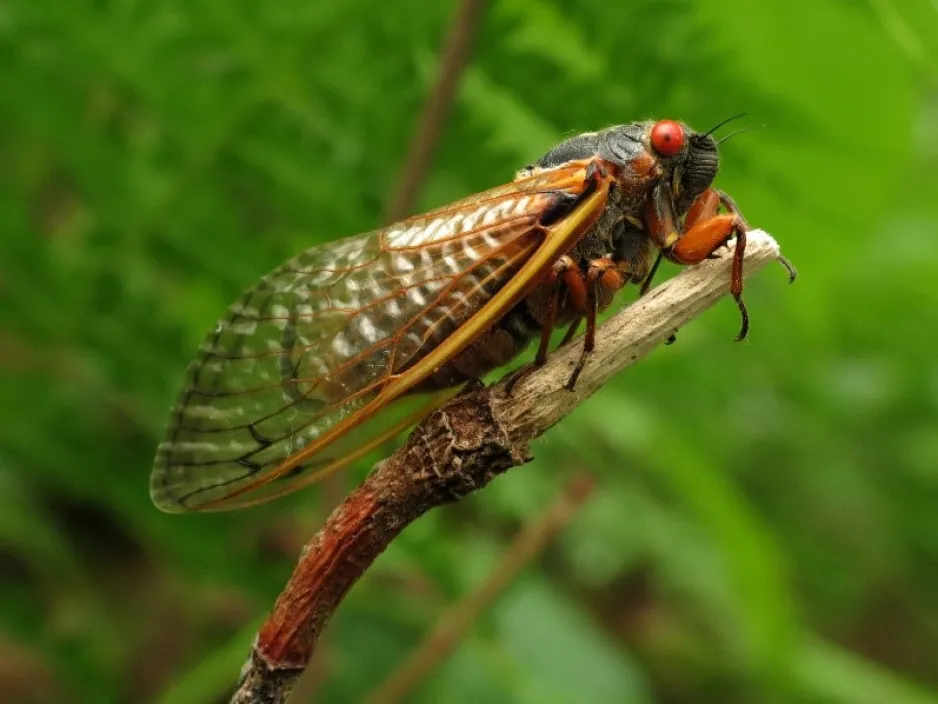
A cicada poses on a flower stalk at Rock Creek Park, in Washington, DC.
Cicadas: Cranking up the sounds of summer
The sounds of spring and summer are quite distinct. For many of us, common nature sounds likely come to mind — specific birds, crickets, grasshoppers, and cicadas. This spring, a large part of the eastern United States will be treated to the sounds of Brood X (pronounced 10) cicadas. This particular type of cicada only emerges once every 17 years, coming out of the ground long enough to reach adulthood, mate, and lay eggs before they die — all within a matter of a few weeks.
Brood X is a periodical cicada species, meaning all members of the population develop at the same rate, which is quite unique. When cicadas are in the nymph stage, they live underground and feed off plant root juices. Once the nymphs are mature, they begin to tunnel out of the ground, usually between the end of April and the beginning of June. From there, they go through a final molt, where they shed their “skin” and, after a few days, reach adulthood. During this very short and final period of their lives, they have one purpose — reproducing. After mating happens, females cut slits into twigs, where they lay around 600 eggs. Once the eggs hatch later in the summer, the nymphs fall to the ground and the process starts all over again.
During mating, males produce a loud sound with their tymbals and females respond to these calls with timed wing-flicks. A group of males — called a chorus — can make sounds that reach 100 decibels, which would be a noise level similar to a power lawn mower, motorcycle, jackhammer, or garbage truck.
Brood X is special because it is the largest of the broods, with some estimates suggesting the total number is in the trillions. It’s hard for us to conceive what trillions of anything looks like. If we think about the number of people living in Canada right now, that’s about 37.5 million people. The population of the world is about 7.8 billion. We would still have to multiply that by 1,000 to reach the trillions.
The good news here is that there will be lots of food to go around for birds, reptiles, squirrels, cats, and other mammals. Some researchers think that periodical cicadas reproduce in such large numbers as a way of ensuring their survival. There are so many of them, they simply can’t all be consumed by their predators — guaranteeing that the species can reproduce again.
By Olivia Béchard



